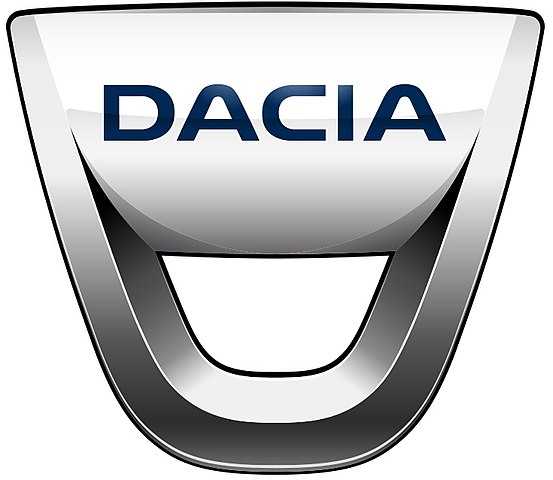Dacia Duster 2023 Maintenance User Manual
The 2023 Dacia Duster is just like its predecessors in that it is reliable and good value for money. This small SUV has fans all over the world because it looks tough but is still easy to drive. But even though it is reliable and well-built, the best way to make sure your Dacia Duster works well for years to come is to keep it in good shape. Regular maintenance is the key to keeping the car’s efficiency, safety, and drive experience as good as possible. This detailed guide goes over all the important parts of taking care of your 2023 Dacia Duster. It will teach you everything you need to know to keep this great SUV running smoothly and reliably for many adventures to come. From changing the oil to taking care of the tires, the engine parts to the comfort of the inside, every aspect of maintenance is covered in detail. This gives you the knowledge you need to make good choices and get the most out of your Duster. Whether you’ve owned a Dacia before or this is your first trip with it, this guide will be a helpful companion on your way to stress-free and enjoyable driving adventures.
Maintenance
Bonnet
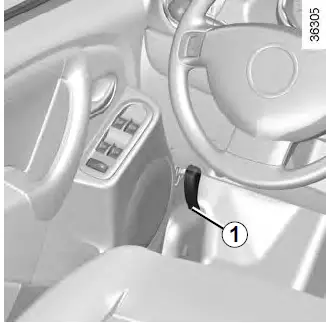
To open the bonnet, pull handle 1.
Unlocking the bonnet catch
To unlock, raise the bonnet slightly and release hook 2 by pushing tab 4 to the left.
The engine may be hot during operations in close proximity. In addition, the engine cooling fan may come on at any moment. Risk of injury.
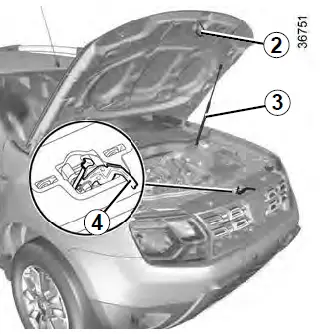
Opening the bonnet
Lift the bonnet and guide it upwards; it is held by strut 3.
Closing the bonnet
Check that nothing has been left in the engine compartment.
To close the bonnet again, hold the bonnet in the middle and lower it to 30 cm above the closed position, then release it. It will latch automatically under its own weight.
Do not press down on the bonnet: there is a risk that the bonnet may accidentally close.
When working in the engine compartment, ensure that the windscreen wiper stalk is in the park position.
Risk of injury.
Ensure that the bonnet is properly locked. Check that nothing is preventing the catch from locking (gravel, cloth, etc.).
Make sure nothing is left in the engine compartment (cloth, tools, etc.).
Otherwise, this may lead to engine damage or cause a fire.
In the event of even a slight impact involving the radiator grille or bonnet, have the bonnet lock checked by an approved Dealer as soon as possible.
ENGINE OIL LEVEL: General Information
It is normal for an engine to use oil for lubrication and cooling of moving parts and it is normal to top up the level between oil changes.
However, contact your approved Dealer if more than 0.5 litres is being consumed every 600 miles (1,000 km) after the running in period.
Oil change frequency: check the oil level from time to time and certainly before any long journey to avoid the risk of damaging your engine.
Consult your approved dealer at once if you notice an abnormal or repeated drop in any of the fluid levels.
In order to prevent splashback, it is recommended that a funnel be used when topping up/filling with oil.

Reading the oil level
The oil level should be read with the vehicle on level ground, after the engine has been switched off for some time.
The dipstick must be used to read the exact oil level and make sure that the maximum level has not been exceeded (risk of engine damage). Refer to the following pages.
- Remove the dipstick and wipe with a clean, lint-free cloth;
Push the dipstick in as far as it will go (for vehicles equipped with a cap-type dipstick C, screw the cap in as far as it will go);
Take out the dipstick again;
Read the level: it should never fall below minimum mark A or exceed maximum mark B.
Once the operation has been completed, ensure that the dipstick is pushed in as far as it will go or that the “cap-type dipstick” is completely screwed in.
Exceeding the maximum engine oil level
Under no circumstances must the maximum fill level B be exceeded: risk of damage to the engine and catalytic converter.
If the oil level exceeds the maximum level, do not start your vehicle. Contact an authorized dealer.
ENGINE OIL LEVEL: Topping up, Filling
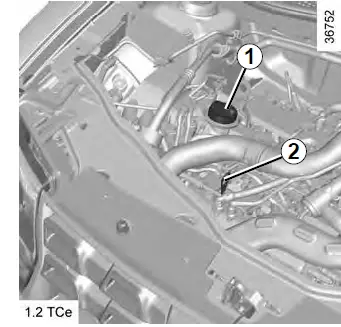
Topping up/filling
The vehicle must be parked on level ground and the engine should be cold (for instance, before the engine is started up for the first time in the day).
- Unscrew cap 1;
Top up the level (as a guide, the capacity between the minimum and maximum reading on dipstick 2 is between 1.5 and 2 litres, depending on the engine);
Wait approximately 10 minutes to allow the oil to flow into the engine;
Check the level using the dipstick 2.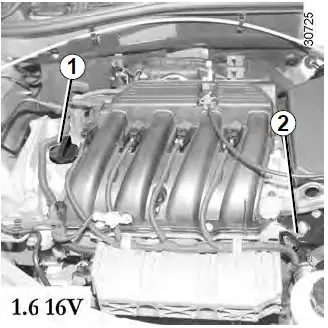
Once the operation has been completed, ensure that the dipstick is pushed in as far as it will go or that the capacity type dipstick is completely screwed in.
Do not exceed the MAX level and do not forget to refit dipstick 2 and cap 1.
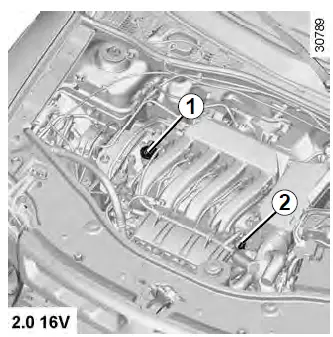
Exceeding the maximum engine oil level
Under no circumstances must the maximum fill level be exceeded: risk of damage to the engine and catalytic converter.
If the oil level exceeds the maximum level, do not start your vehicle. Contact an authorized dealer
If there is an abnormal or repeated drop in the fluid level, please consult an authorized dealer.
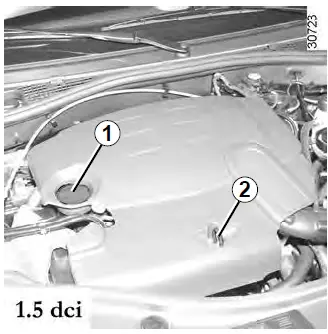
In order to prevent splash back, it is recommended that a funnel be used when topping up/filling with oil.
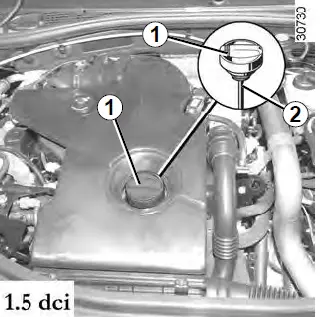
Oil change
Service interval: refer to the Maintenance Document for your vehicle.
Oil change capacity
Please refer to the maintenance document for your vehicle, or contact an authorised dealer.
Always check the engine oil level using the dipstick, as explained previously (it should never fall below the minimum level, or be over the maximum level on the dipstick).
Engine oil grade
Refer to the Maintenance Document for your vehicle.
Engine oil change: if you are changing the oil when the engine is hot, be careful not to scald yourself if the oil overflows.
Resetting the alert after an oil change (depending on the vehicle)
If you change the oil yourself, you will need to reset the oil change warning.
To do this, after switching on the ignition, for ten seconds you must:
- Depress the accelerator pedal fully,
With your foot on the accelerator, depress the brake pedal three times in succession.
Reinitialisation is complete when the indicator light goes out. If this is not the case, repeat the operation.
Special case: if you change the oil before the oil change interval exceeded warning is displayed, it will also be necessary to reset the display. In this case, the # warning light comes on for approximately 5 seconds to confirm the reset.
Never run the engine in an enclosed space as exhaust gases are poisonous.
Exceeding the maximum engine oil level
Under no circumstances must the maximum fill level
be exceeded: risk of damage to the engine and catalytic converter.
If the oil level exceeds the maximum level, do not start your vehicle. Contact an authorised dealer.
The engine may be hot during operations in close proximity. In addition, the engine cooling fan may come on at any moment. Risk of injury.

Brake fluid level
This should be checked frequently, and immediately if you notice even the slightest loss in braking efficiency.
The level should be read with the engine switched off and on level ground.
The engine may be hot when carrying out operations in close proximity. In addition, the engine cooling fan can come on at any moment. Risk of injury.
Level
It is normal for the level to drop as the brake shoes become worn, but it must never drop lower than the “MINI” warning line shown on brake fluid reservoir 1.
If you wish to check the disc and drum wear yourself, you should obtain the document explaining the checking procedure from the manufacturer’s net-work or web site.
Topping up
After any operation on the hydraulic circuit, a specialist must replace the fluid.
Only use fluids approved by our Technical Department (and taken from a sealed container).
Replacement intervals
Refer to the Maintenance Document for your vehicle.
Consult your approved dealer at once if you notice an abnormal or repeated drop in any of the fluid levels.
Coolant
With the engine switched off and on level ground, the level when cold must be between the MINI and MAXI marks on reservoir 2.
Top this level up when cold before it reaches the MINI mark.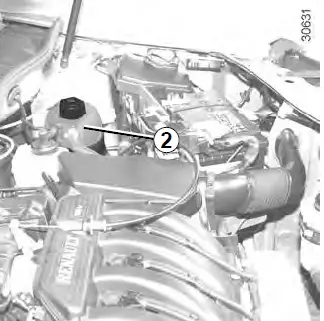 Coolant level checking frequency
Coolant level checking frequency
Check the coolant level regularly (very severe damage is likely to be caused to the engine if it runs out of coolant).
If the level needs to be topped up, only use products approved by our Technical Department which ensure:
- protection against freezing;
Anticorrosion protection of the cooling system. - Replacement intervals
Refer to the Maintenance Document for your vehicle.
Consult your approved dealer at once if you notice an abnormal or repeated drop in any of the fluid levels.
The engine may be hot when carrying out operations in close proximity. In addition, the engine cooling fan can come on at any moment. Risk of injury.
Windscreen washer reservoir
Filling: Remove cap 3, fill until you can see the fluid, then refit the cap.
This reservoir supplies the front and rear screen washers.
Liquid: Special windscreen washer fluid (anti-freeze product in winter).
Jets: to adjust the angle of the jets, pivot the little ball using a pin.
Use products approved by the Technical Department.
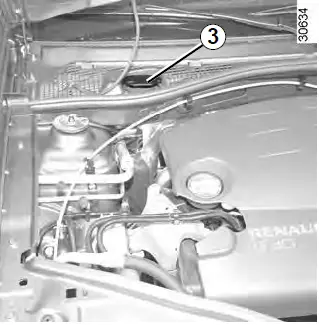
Power-assisted steering fluid reservoir 4 or 5
Level: for a correct level when cold, with the engine switched off and on level ground, it must be visible between the “MINI” and “MAXI” marks on reservoir 4 or 5.
For maintenance operations on the power-assisted steering, contact an approved dealer.

Consult an approved dealer at once if you notice an abnormal or repeated drop in any of the fluid levels.
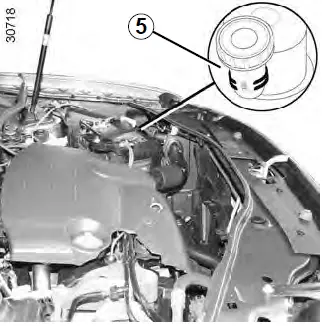
If you feel any variation in the effectiveness of the power-assisted steering, consult an approved dealer.
The engine may be hot when carrying out operations in close proximity. In addition, the engine cooling fan can come on at any moment. Risk of injury.
FILTERS
The replacement of filter elements (air filter, passenger compartment filter, diesel filter, etc.) is scheduled in the maintenance operations for your vehicle.
Replacement intervals for filter elements: refer to the Maintenance Document for your vehicle.
Passenger compartment filter
If your vehicle is not originally fitted with a passenger compartment filter, it is possible to have one retrofitted.
Contact an approved dealer.

Air filter
If fitted to the vehicle, clogging sensor 1 allows you to see the condition of the air filter.
Replacement of the filter is scheduled in the maintenance operations: refer to your vehicle’s Maintenance Document for your vehicle.
However, it must be checked regularly, especially if you drive in dusty environments.
If clogging level indicator 2 reaches 100%, consult an approved dealer as soon as possible to have the filter re-placed.
Resetting the air filter clogging sensor
Once the air filter has been replaced, turn button 3 on the clogging sensor fully (movement A).
The engine may be hot when carrying out operations in close proximity. In addition, the engine cooling fan can come on at any moment. Risk of injury.
TYRE PRESSURE
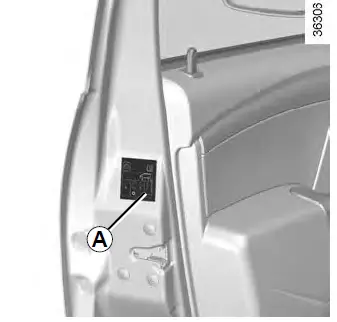
Label A
To read it, open the driver’s door. Tyre pressures should be checked when the tyres are cold.
If the tyre pressures cannot be checked when the tyres are cold, increase the pressures from 0.2 to 0.3 bar (or 3 PSI). Never deflate a hot tyre.
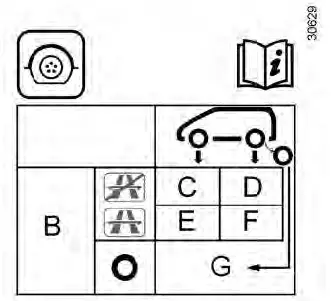
B: dimension of the tyres fitted to the vehicle.
C: tyre pressures for the front wheels (non-motorway).
D: tyre pressures for the rear wheels (non-motorway).
E: tyre pressures for the front wheels (motorway).
F: tyre pressures for the rear wheels (motorway driving).
G: tyre pressure for the emergency spare wheel.
Special note concerning fully laden vehicles (Maximum Permissible All-Up Weight) and towing a trailer: the maxi-mum speed must be limited to 60 mph (100 kph) and the tyre pressure increased by 0.2 bar.
Please refer to the information on “Weights” in Section 6.
Tyre safety and use of snow chains: Refer to the information on “Tyres” in Section 5 for the servicing conditions and, depending on the version, the use of chains
When they need to be replaced, only tyres of the same make, size, type and profile should be used on a single axle.
They must: either be identical to those fitted originally or conform to those recommended by an authorized dealer.
BATTERY

Battery 1 does not require any maintenance.
Handle the battery with care as it contains sulphuric acid, which must not come into contact with eyes or skin. If it does, wash the affected area with plenty of cold water and consult a doctor, if necessary.
Ensure that naked flames, red hot objects and sparks do not come into contact with the battery as there is a risk of explosion.
The charge status of your battery can decrease especially if you use your vehicle:
- For short journeys;
For driving in town;
When the temperature drops;
After extended use of consumers (radio etc.) with the engine switched off.
Replacing the battery
As this operation is complex, we advise you to contact an approved Dealer.
As the battery is specific to the vehicle (presence of a ventilation pipe to expel corrosive and explosive gases), make sure that it is replaced with a battery that enables this pipe to be connected. Please contact an authorized dealer.

Label A
Observe the indications on the battery:
- 2Naked flames and smoking forbid-den;
- 3 Wear eye protection;
- 4 Keep away from children;
- 5 Explosive substances;
- 6 Refer to the handbook;
- 7 Corrosive substances.
The engine may be hot during operations in close proximity. In addition, the engine cooling fan may start at any moment. Risk of injury.
BODYWORK MAINTENANCE
A well-maintained vehicle will last longer. It is therefore recommended to maintain the exterior of the vehicle regularly.
Your vehicle has been treated with very effective anti-corrosion products. It is nevertheless subject to various outside influences.
Corrosive agents in the atmosphere
- Atmospheric pollution (built-up and industrial areas),
Saline atmospheres (near the sea, particularly in hot weather),
Seasonal and damp weather conditions (e.g. road salt in winter, water from road cleaners, etc.).
Minor impacts
Abrasive action
Dust and sand in the air, mud, road grit thrown up by other vehicles, etc .vehicle against such risks.
What you should not do
Do not degrease or clean mechanical components (e.g. the engine compartment), underneath the body, parts with hinges (e.g. inside the doors) and painted plastic external fittings (e.g. bumpers) using high-pressure cleaning equipment or by spraying on products not approved by our Technical Department. Doing this could give rise to corrosion or operational faults.
Wash the vehicle in bright sunlight or freezing temperatures.
Do not scrape off mud or dirt without pre-wetting.
Allow dirt to accumulate on the exterior.
Allow rust to form following minor impacts.
Do not use solvents not approved by our Technical Department to remove stains as this could damage the paint-work.
Do not drive in snow or muddy conditions without washing the vehicle, particularly under the wheel arches and body.
You should
Wash your car frequently, with the engine off, with cleaning products recommended by the manufacturer (never use abrasive products). Rinse thoroughly beforehand with a jet:
- Spots of tree resin and industrial grime;
Mud in the wheel arches and underneath the body which forms damp patches;
Bird droppings, which cause a chemical reaction with the paint that rapidly discolors paintwork and may even cause the paint to peel off;
wash the vehicle immediately to remove these marks since it is impossible to remove them by polishing;
Salt, particularly in the wheel arches and underneath the body after driving in areas where the roads have been gritted.
Remove any plant matter (resin, leaves, etc.) from the vehicle regularly.
Respect local regulations about washing vehicles (e.g. do not wash your vehicle on a public highway).
Observe the vehicle stopping distances when driving on graveled surfaces to prevent paint damage.
Repair, or have repaired quickly, areas where the paint has been damaged, to prevent corrosion spreading.
Remember to visit the body shop periodically in order to maintain your anti-corrosion warranty. Refer to the Maintenance Document.
If it is necessary to clean mechanical components, hinges, etc., spray them with products approved by our Technical Department to protect them after they have been cleaned.
Vehicles with a matte paint finish
This type of paint requires certain pre-cautions.
Do not do the following
- Use wax-based products (polishing);
Rub hard;
Wash the vehicle in a roller-type car wash;
Wash the vehicle using a high-pressure device;
Attach stickers to the paintwork (risk of leaving marks).
You should do the following
Wash the vehicle by hand using plenty of water, using a soft cloth or a gentle sponge.
Using a roller type car wash
Return the windscreen wiper stalk to the Park position (refer to the information on the “Windscreen washer, wiper” in Section 1). Check the mounting of external accessories, additional lights and mirrors, and ensure that the wiper blades are secured with adhesive tape. Remove the radio aerial mast if your vehicle is fitted with this equipment. Remember to remove the tape and refit the antenna after washing.
Cleaning the headlights
As the headlights are made of plastic “glass”, use a soft cloth or cotton wool to clean them. If this does not clean them properly, moisten the cloth with soapy water, then wipe clean with a soft damp cloth or cotton wool.
Finally, carefully dry off with a soft dry cloth.
Cleaning products containing alcohol must not be used.
INTERIOR TRIM MAINTENANCE
A well-maintained vehicle will last longer. It is therefore recommended to maintain the interior of the vehicle regularly.
A stain should always be dealt with swiftly.
Whatever type of stain is on the trim, use cold (or warm) soapy water with natural soap.
Detergents (washing-up liquid, powdered products, alcohol-based products) should not be used.
Use a soft cloth.
Rinse and soak up the excess.
Glass instrument panel
(e.g. instrument panel, clock, exterior temperature display, radio display, etc.)
Use a soft cloth (or cotton wool).
If this does not clean it properly, use a soft cloth (or cotton wool) slightly moistened with soapy water and then wipe clean with a soft damp cloth or cotton wool.
Finally, carefully dry off with a soft dry cloth.
Cleaning products containing alcohol must not be used under any circumstances.
Seat belts
These must be kept clean.
Use products selected by our Technical Department (Approved outlets) or warm, soapy water and a sponge and wipe with a dry cloth.
Detergents or dyes must not be used under any circumstances.
Textiles (seats, door trim, etc.)
Vacuum-clean the textiles regularly.
Liquid stain
Use soapy water.
Dab lightly (never rub) with a soft cloth, rinse and remove the excess.
Solid or pasty stain
Carefully remove the excess solid or pasty material immediately with a spatula (working from the edges to the center to avoid spreading the stain). Clean as for a liquid stain.
Special instructions for sweets or chewing gum
Put an ice cube on the stain to solidify it, then proceed as for a solid stain.
For further recommendations for maintaining the interior, and/or for any unsatisfactory results, please see an authorized dealer.
- Removal/replacing removable equipment originally fitted in the vehicle
If you need to remove equipment in order to clean the passenger compartment (for example, mats), always ensure that they are correctly refitted and are the right way around (the driver’s mat should be fitted on the driver’s side, etc.) and fit them with the components supplied with the equipment (for example, the driver mat should always be fixed using the pre-fitted mounting components).
With the vehicle stationary, ensure that nothing will impede driving (anything obstructing the pedals, heel wedged by the mat, etc.).
You should not:
You are strongly advised not to position objects such as deodorants, scents, etc. near air vents, as this could damage your dashboard trim. - You are strongly recommended not to use high-pressure or spray cleaning equipment inside the passenger compartment: use of such equipment could impair the correct functioning of the electrical or electronic components in the vehicle, or have other detrimental effects
FAQ
Dacia recommends changing the oil in your Duster every 10,000 to 15,000 miles, or once a year, whichever comes first.
You should use the oil recommended in your vehicle’s owner’s manual. Typically, it’s a high-quality synthetic oil.
Tire rotation is generally recommended every 6,000 to 8,000 miles to ensure even wear.
The recommended tire pressure can vary depending on the tire size and load, but it’s usually found in the owner’s manual and on a sticker inside the driver’s door jamb.
Air filters should be checked and replaced if necessary every 15,000 to 30,000 miles, or as specified in your owner’s manual.
The cabin air filter should be replaced every 15,000 to 30,000 miles, or as specified in your owner’s manual.
Spark plug replacement intervals can vary, but it’s typically recommended every 30,000 to 100,000 miles. Check your owner’s manual for specifics.
Coolant should typically be changed every 2 to 5 years, depending on the type of coolant used. Consult your owner’s manual for specific recommendations.
Brake pad wear can vary greatly depending on driving habits, but a general guideline is to inspect them every 20,000 to 60,000 miles and replace them as needed.
Transmission fluid change intervals can vary, but it’s often recommended every 30,000 to 60,000 miles. Check your owner’s manual for specific guidance.
The timing belt replacement interval varies by engine type, but it’s typically recommended every 60,000 to 100,000 miles or 5 to 7 years, whichever comes first.
Suspension components should be inspected at regular intervals, such as during routine maintenance or when you notice unusual noises or handling issues.
It’s a good idea to have the wheel alignment checked when you notice uneven tire wear or if you’ve hit a pothole or curb.
Battery life can vary, but on average, a car battery may last 3 to 5 years. Check your battery’s condition during regular maintenance.
It’s highly recommended to follow the manufacturer’s service schedule as closely as possible to ensure the longevity and reliability of your Dacia Duster. Failure to do so may void warranty coverage.
Useful Link
View Full User Guide: Dacia Duster 2023 User Manual
Dacia Duster 2023 Lights and Indicators User Manual


